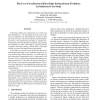Free Online Productivity Tools
i2Speak
i2Symbol
i2OCR
iTex2Img
iWeb2Print
iWeb2Shot
i2Type
iPdf2Split
iPdf2Merge
i2Bopomofo
i2Arabic
i2Style
i2Image
i2PDF
iLatex2Rtf
Sci2ools
IWPC
2009
IEEE
2009
IEEE
The loss of architectural knowledge during system evolution: An industrial case study
Architecture defines the components of a system and their dependencies. The knowledge about how the architecture is intended to be implemented is essential to keep the system structure coherent and thereby comprehensible. In practice, this architectural knowledge is explicitly formulated only in the documentation (if at all), which usually gets outdated very soon. This leads to a growing amount of implicit knowledge during evolution that is especially volatile in projects with high developer fluctuation. In this paper we present a case study about the loss of architectural knowledge in three industrial projects to answer the following research questions: 1) to what degree is the architectural documentation kept in conformance with the code? 2) how well does the documentation reflect the intended architecture?, 3) how big is the architectural decay?, and 4) what are the causes for nonconformances? We answer these questions by investigating the architecture documentation, the source ...
Architectural Knowledge | Documentation | Intended Architecture | IWPC 2009 | Software Engineering |
| Added | 24 May 2010 |
| Updated | 24 May 2010 |
| Type | Conference |
| Year | 2009 |
| Where | IWPC |
| Authors | Martin Feilkas, Daniel Ratiu, Elmar Jürgens |
Comments (0)

